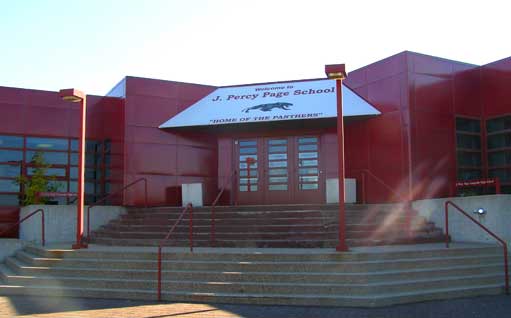
ATLAS e-News
23 February 2011
Live connection between Canadian high school students and Canadian scientists at CERN
16 June 2008

Percy Page School of Alberta, where half of the action took place
“What is a lepton, and what is a quark?”, “Why does gravity bend a light beam if it has no mass?”, “How can the Higgs boson give a particle mass?” Those were some of the questions that came up during a videoconference at the end of May between a group of students from six different High Schools in Alberta, Canada and Canadian physicists based at CERN.
The idea of a live connection with CERN came from the teacher Alex Kennedy of the J. Percy Page School, and it was organised by Mick Storr, coordinator of teacher’s programmes in the CERN’s education group. The Canadian teacher was concerned about the short month that the Physics curriculum in Canada allows to cover physical discoveries of the twentieth century. He thought that his students needed to get more familiar with modern physics fields, such as particle physics and quantum mechanics: “These subjects are in fact essential to most modern technology and connecting with CERN was a way to emphasise their importance,” explains Alex.
In his experience, and contrary to the common belief about the lack of interest of high school students in science, Alex found that a lot of his students were very curious about the nature of the Universe and how CERN physicists could contribute to unveil its mysteries: “The students really wanted to know what matter is at its deepest level and why natural law works the way it does,” he says.
Hot topics in physics that are currently hitting the headlines around the world also drew the students’ curiosity and they seized the opportunity to ask physicists how research at CERN is connected to concepts they have read in the press, such as dark matter, dark energy and black holes.
The videoconference was also an excellent opportunity to turn particle physics, which can sometimes be a very abstract subject, into something down-to-earth and useful. Marc-André Dufour, a Canadian graduate student from McGill university who participated in the videoconference noticed a considerable interest from the students in the applications of particle physics in everyday life: “A lot of the questions that were asked by the students were actually related to the physics that we do at CERN, and how they impact their lives through the various technology they see around them nowadays.” The students, Marc André explains, seemed eager to see what else CERN can produce after the World Wide Web.
With his contribution, Marc-André also wanted to help debunk the stereotype of physicists and get across the message that a job in physics is a feasible and exciting career option for students interested in science: “Sure there are people here at CERN that are incredibly smart, but I wanted to help make students understand that we're not only work, that being a physicist is a fun job, and that you don't have to be Einstein or Feynman to be able to make a career out of physics,” he says.
Veterans in the field of particle physics also got involved in the videoconference. Michel Lefebvre, who has been Professor of Physics at the University of Victoria for 17 years remembers the experience with great satisfaction: “The students had very good questions! I had the clear impression that they were pleased with the event. It also came across that they do follow some of the big scientific questions of our time and that they want to know more about them.”
Michel is a big supporter of CERN’s long tradition of bringing real science close to students, teachers and the general public, so participating in the videoconference was for him a very good opportunity to let many Canadian high school students know more about CERN and about Canadians involved in ATLAS: “I am also pretty sure that some of the students that participated in the videoconference will end up in scientific careers, perhaps even on ATLAS in a few years!” he says.
And he might be quite right. As teacher Alex Kennedy explains, during the videoconference students did not ask questions to physicists about what life is like at CERN, or how they could get a job here, however, he adds, they did ask these sorts of questions afterwards.
The experience was rewarding for both students and physicists. More videoconferences are planned between CERN and schools all over the world with the aim of connecting the physics of ATLAS and CERN with prospective physicists of the future.
If you are physicist interested in talking to young people in your country and already have school contacts please get in touch with mick.storr@cern.ch.
